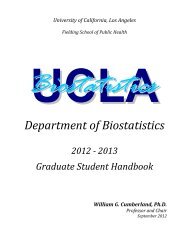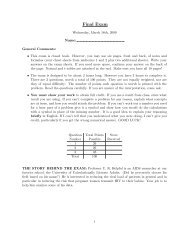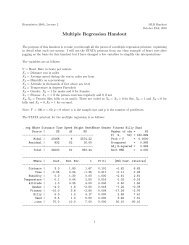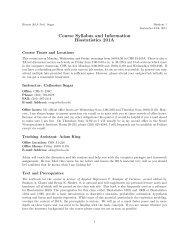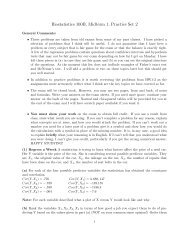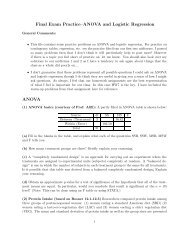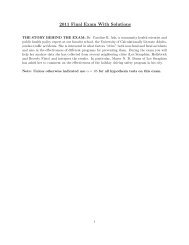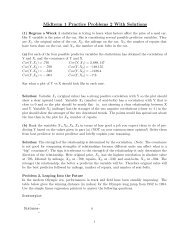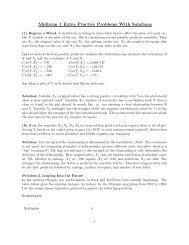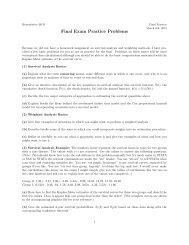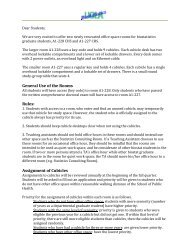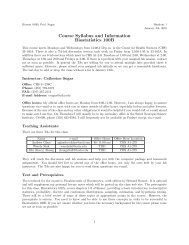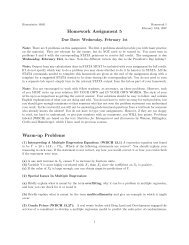FINAL PROJECT Basic Description of the Project Instructions For ...
FINAL PROJECT Basic Description of the Project Instructions For ...
FINAL PROJECT Basic Description of the Project Instructions For ...
- No tags were found...
Create successful ePaper yourself
Turn your PDF publications into a flip-book with our unique Google optimized e-Paper software.
Biostat 200A<strong>FINAL</strong> <strong>PROJECT</strong>Due Date: Friday, December 3rdFinal <strong>Project</strong>November 22nd, 2010<strong>Basic</strong> <strong>Description</strong> <strong>of</strong> <strong>the</strong> <strong>Project</strong>The goal <strong>of</strong> <strong>the</strong> project is to analyze a real data set, appropriately interpret your findings, and to write upyour results in <strong>the</strong> form <strong>of</strong> a consulting report. You may choose one <strong>of</strong> two data sets which are described inmore detail below. The first data set, SENIC, deals with length <strong>of</strong> stay and infection rates in U.S. hospitals.The second data set, CDI, focuses on crime rates in U.S. counties. The two data sets have somewhat differentissues but I do not consider one to be significantly harder than <strong>the</strong> o<strong>the</strong>r so pick whichever one looks moreinteresting to you. It should also be noted that <strong>the</strong>re isn’t a single “right” answer and <strong>the</strong>re are a myriad<strong>of</strong> different issues that you could discuss, so use your imagination and think about all <strong>the</strong> topics we havecovered over <strong>the</strong> course <strong>of</strong> <strong>the</strong> quarter. Whichever data set you pick, you will need to analyze one continuousoutcome variable using multiple linear regression and one dichotomous outcome using logistic regression.The multiple linear regression is <strong>the</strong> primary analysis since we will only have time for a brief introduction tologistic regression. Do <strong>the</strong> MLR first and use it to inform your choices for <strong>the</strong> logistic regression. There isalso an optional component to <strong>the</strong> project which you may do for extra credit if you wish (but do it only aftercompleting <strong>the</strong> rest <strong>of</strong> <strong>the</strong> project!) Details <strong>of</strong> what I expect you to include in your analyses and write-upup are given below along with descriptions <strong>of</strong> <strong>the</strong> two data sets. Note that for each data set <strong>the</strong>re are somespecific issues which I have listed along with <strong>the</strong> variable descriptions.<strong>Instructions</strong> <strong>For</strong> Statistical ModelingWhichever data set you are using, <strong>the</strong> following approaches and issues may be helpful to consider:• Exploratory Analyses: It is advisable to start with a set <strong>of</strong> exploratory analyses to examine <strong>the</strong>distributions <strong>of</strong> <strong>the</strong> variables and <strong>the</strong> relationships between pairs <strong>of</strong> variables. This will help you identifypotential problems including possible outliers, multicollinearity and <strong>the</strong> need for transformations.• Preliminary Models: Likewise it is a good idea to fit simple linear regressions <strong>of</strong> your outcome oneach <strong>of</strong> <strong>the</strong> main predictors and a global model <strong>of</strong> <strong>the</strong> outcome on all <strong>the</strong> predictors toge<strong>the</strong>r to geta feel for what is going on. In particular notice whe<strong>the</strong>r <strong>the</strong>re are any interesting differences betweenyour simple linear regressions and <strong>the</strong> overall model.• Transformations and Deriving New Variables: Transformations will be very important in thisproject for several reasons. In addition to using <strong>the</strong>m to get <strong>the</strong> right shaped relationships or to fixo<strong>the</strong>r problems with <strong>the</strong> regression assumptions you may want to create new variables because <strong>the</strong>ywill be more relevant, more interpretable, or will help you to deal with multicollinearity. You shouldthink about this BEFORE you start building your final model.• Regression Diagnostics: Validity <strong>of</strong> <strong>the</strong> regression assumptions and handling <strong>of</strong> outliers will also beimportant in this project. Make sure you create an appropriate set <strong>of</strong> diagnostics plots and statisticsfor your final model as well as describing any intermediate checks you performed to help you identifyproblems with your preliminary models. Carefully justify your decisions about whe<strong>the</strong>r or not toexclude outliers.1
• Interactions, Confounding, Mediation, etc.: There are a number <strong>of</strong> possible interactions in <strong>the</strong>sedata sets. Think carefully about how <strong>the</strong> relationships <strong>of</strong> <strong>the</strong> various predictors with Y might dependon one ano<strong>the</strong>r. Also consider any possible cases <strong>of</strong> mediation or confounding and how <strong>the</strong>se mightaffect your interpretation <strong>of</strong> your models.• Model Selection: The ultimate goal <strong>of</strong> <strong>the</strong> project is to come up with a pair <strong>of</strong> models (one linear,one logistic) that best describe <strong>the</strong> relationships between your predictors and your outcomes <strong>of</strong> interest.Be sure you describe carefully <strong>the</strong> set <strong>of</strong> procedures you use to identify your final model. This mayrepresent a mixture <strong>of</strong> techniques.• Prediction: Frequently one uses statistical models to make predictions for new observations. As part<strong>of</strong> your write-up use each <strong>of</strong> your final models to make predictions for what you think would be aninteresting or important combination <strong>of</strong> your predictor values, briefly explaining your choices.Write-upYour findings should be written up as a statistical consulting report, aimed at a public health audience, inwhich you describe <strong>the</strong> data set and <strong>the</strong> goals <strong>of</strong> <strong>the</strong> analysis, explain <strong>the</strong> procedures you used to arrive atyour final models, and present interpretations <strong>of</strong> <strong>the</strong> parameters <strong>of</strong> those models in an accurate and usefulmanner, along with appropriate predictions based on those models. You should also describe any problemsyou encountered and how you resolved <strong>the</strong>m, carefully justifying your choices. Finally, your report will beenhanced by discussing <strong>the</strong> implications <strong>of</strong> your models in <strong>the</strong> context <strong>of</strong> <strong>the</strong> problem and any limitations<strong>of</strong> <strong>the</strong> data set for answering <strong>the</strong> questions <strong>of</strong> interest. Your report will be evaluated in part based on yourability to communicate insights about how <strong>the</strong> predictor variables (hospital or population characteristics)relate to <strong>the</strong> outcomes (length <strong>of</strong> hospital stay/risk <strong>of</strong> infection, crime rate/high poverty rate). It is <strong>the</strong>reforeimportant to be clear about your motivation for carrying out <strong>the</strong> analyses as well as about <strong>the</strong> technicalinterpretations <strong>of</strong> <strong>the</strong> models.Your main report should be on <strong>the</strong> order <strong>of</strong> 5-7 pages. You may include an appendix with computeroutput and graphics if you feel <strong>the</strong>y will provide a useful reference. However, keep in mind that youraudience (myself included!) does NOT want to have to sift through reams <strong>of</strong> printouts. Include ONLY whatis genuinely useful and excise any parts <strong>of</strong> <strong>the</strong> printouts to which you will not refer. Any really criticalgraphics should be included in <strong>the</strong> main text. Some key information may be better summarized in tablesthan by including <strong>the</strong> printouts (e.g. it may be enough to give regression coefficients and p-values withoutall <strong>the</strong> accompanying information provided by STATA or SAS). Make sure that all tables, graphs, etc., areclearly labeled. The body <strong>of</strong> your report should include <strong>the</strong> following sections:• Introduction: Provide a brief descrption <strong>of</strong> <strong>the</strong> data set and <strong>the</strong> goals <strong>of</strong> your analysis for someonewho is unfamiliar with <strong>the</strong> project. Note that <strong>the</strong>re are multiple possible motivations for <strong>the</strong>se analyses.Make it clear from what point <strong>of</strong> view you are examining <strong>the</strong> data.• Statistical Methods: State what analysis strategies you used, noting relevant models or assumptions.While it may be helpful in some cases to describe your analysis sequentially, do not take <strong>the</strong> readerdown every false path you tried. It is more important that <strong>the</strong> order <strong>of</strong> presentation be consistent withyour ultimate conceptual view <strong>of</strong> <strong>the</strong> problem than with your initial approach.• Results: Give a summary <strong>of</strong> your main findings regarding relationships between <strong>the</strong> predictor andoutcome variables along with interpretations relating to <strong>the</strong> magnitude, direction, statistical significanceand interdependencies <strong>of</strong> those relationships.• Discussion/Conclusion: Give highlights <strong>of</strong> interesting or important conceptual findings and discussany o<strong>the</strong>r important issues that arose in <strong>the</strong> course <strong>of</strong> <strong>the</strong> analysis and <strong>the</strong>ir implications for yourconclusions. This is where you get to be creative and combine your public health knowledge with yourstatistical skills!2
Data Set I: SENICThis data set comes from <strong>the</strong> Study on <strong>the</strong> Efficacy <strong>of</strong> Nosocomial Infection Control (SENIC study). Theoriginal objective <strong>of</strong> <strong>the</strong> study was to determine whe<strong>the</strong>r infection surveillance and control programs reducedrates <strong>of</strong> nosocomial (hospital-acquired) infections in U.S. hospitals. We will focus on a narrower set <strong>of</strong>questions about how hostpial characterstics relate to length <strong>of</strong> patient stay and risk <strong>of</strong> infection. In <strong>the</strong> dataset available to us, <strong>the</strong>re are 113 hospitals (indexed by ID number), with 11 quantities measured on each:VARIABLE NAMEDESCRIPTIONid Hopsital ID number ranging from 1-113lengthageriskculturexraybedsmschregioncensusnursessvcsAverage length <strong>of</strong> stay (in days) <strong>of</strong> all patients in <strong>the</strong> hospitalAverage age (in years) <strong>of</strong> all patients in <strong>the</strong> hospitalInfection risk measured as <strong>the</strong> estimated probability (in percent) <strong>of</strong> acquiringan infection in <strong>the</strong> hospitalRatio <strong>of</strong> number <strong>of</strong> cultures performed to number <strong>of</strong> patients without signsor symptoms <strong>of</strong> hospital acquired infections, times 100Ratio <strong>of</strong> number <strong>of</strong> x-rays performed to number <strong>of</strong> patients without signs orsymptoms <strong>of</strong> pneumonia, times 100Average number <strong>of</strong> beds in hospital during study periodWhe<strong>the</strong>r <strong>the</strong> hospital was affiliated with a medial school: 1 = Yes, 2 = NoGeographic area <strong>of</strong> <strong>the</strong> U.S. in which <strong>the</strong> hospital was located1 = Nor<strong>the</strong>ast, 2 = North Central, 3 = South, 4 = WestAverage number <strong>of</strong> patients in hospital per day during <strong>the</strong> study periodAverage number <strong>of</strong> full-time equivalent registered and licensed practical nursesduring study period (number full plus half <strong>the</strong> number part time)Percent <strong>of</strong> a list <strong>of</strong> 35 potential facilities and services that were availableat <strong>the</strong> hospitalSpecific Notes for Analyzing <strong>the</strong> SENIC Data Set:• Treat <strong>the</strong> average length <strong>of</strong> stay as <strong>the</strong> outcome variable, Y, for your multiple regression analysis.• Define a new variable “HighRisk” which is 1 if <strong>the</strong> hospital has a risk <strong>of</strong> infection <strong>of</strong> 5% or higher and0 o<strong>the</strong>rwise and use this as <strong>the</strong> outcome variable for your logistic regression model.• One question <strong>of</strong> particular interest for this data set is whe<strong>the</strong>r <strong>the</strong>re are regional differences in <strong>the</strong>relationships between <strong>the</strong> various predictors and length <strong>of</strong> stay or risk <strong>of</strong> infection.• It may be necessary to define a number <strong>of</strong> new variables for this analysis including transformations,interactions, conversion <strong>of</strong> categorical variables to dummy variables and even creation <strong>of</strong> derived variablesthat will be more appropriate for answering <strong>the</strong> questions <strong>of</strong> interest. Think about <strong>the</strong>se choicescarefully before beginning your analysis.3
Data Set II: CDIYour second option is to analyze <strong>the</strong> ”County Demographic Information” (CDI) data set, which containscharacteristics <strong>of</strong> 440 counties in <strong>the</strong> United States collected from 1990-1992. The primary objective <strong>of</strong> thisinvestigation is to develop insight about how population characterstics <strong>of</strong> <strong>the</strong> counties relate to <strong>the</strong> crimerate (which you might want to summarize as <strong>the</strong> number <strong>of</strong> serious crimes per 1,000 people, CRM 1000 ) andto whe<strong>the</strong>r <strong>the</strong> county has a high pverty rate. The variables in <strong>the</strong> CDI data set are as follows:VARIABLE NAMEDESCRIPTIONID An ID number for <strong>the</strong> county, ranging from 1-440ctystateareaA character string giving <strong>the</strong> name <strong>of</strong> <strong>the</strong> countyThe two letter abbreviation for <strong>the</strong> name <strong>of</strong> <strong>the</strong> state continaining <strong>the</strong> countyLand area <strong>of</strong> <strong>the</strong> county in square milespop The estimated population <strong>of</strong> <strong>the</strong> county in 1990pop18 Percentage <strong>of</strong> total population in county aged 18-34 in 1990pop65 Percentage <strong>of</strong> total population aged 65 or older in 1990docs Number <strong>of</strong> pr<strong>of</strong>essionally active nonfederal physicians in 1990beds Number <strong>of</strong> available hospital beds (beds, cribs and bassinets) in 1990crimeshsgradbagradpovertyTotal number <strong>of</strong> serious crimes in 1990 as reported by law enforcement including rape,murder, robbery, aggravated assault, burglary, larceny-<strong>the</strong>ft and motor vehicle <strong>the</strong>ftPercentage <strong>of</strong> persons 25 years or older who completed 12 or more years <strong>of</strong> schoolPercentage <strong>of</strong> persons 25 years or older who had a bachelor’s degreePercentage <strong>of</strong> 1990 total population with income below <strong>the</strong> poverty lineunemp Percentage <strong>of</strong> labor force that was unemployed in 1990pcincometotalincPer capita income, in dollars per person among those in <strong>the</strong> 1990 total populationTotal personal income in millions <strong>of</strong> dollars among those in <strong>the</strong> 1990 total populationregionGeographic area <strong>of</strong> <strong>the</strong> United States, according to <strong>the</strong> U.S. Census Bureauclassified as 1 = Nor<strong>the</strong>ast, 2 = Northcentral, 3 =South 4 = WestSpecific Notes for Analyzing <strong>the</strong> CDI Data Set:• Treat <strong>the</strong> crime rate per thousand people as <strong>the</strong> outcome variable, Y, for your multiple regressionanalysis. (You will have to create this variable.)• Define a new variable “HighPoverty” which is 1 if <strong>the</strong> county has a poverty rate <strong>of</strong> 10% or higher and0 o<strong>the</strong>rwise and use this as <strong>the</strong> outcome variable for your logistic regression model.• In this data set, inter-relationships among <strong>the</strong> predictor variables will have a big effect on your analysis.Before beginning, think about how you might want to define new variables that would both providebetter insight about <strong>the</strong> questions <strong>of</strong> interest and might eliminate some <strong>of</strong> <strong>the</strong> problems caused by <strong>the</strong>existing relationsips.4
Optional ComponentIf you are feeling ambitious you can get bonus credit by writing a one-page abstract in which you describea data set <strong>of</strong> interest to you in your own research, explain briefly how you might analyze it in light <strong>of</strong> whatwe have learned in <strong>the</strong> class, and describe some <strong>of</strong> <strong>the</strong> conceptual issues or problems you might encounter.5



